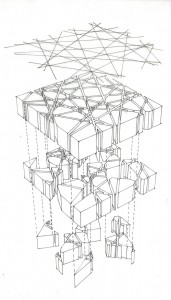
Throughout Toyo Ito’s writings, the relevance of depicting architecture as a tree is expressed through three topics. These include Metaphorical relations, sustainability and the comparison between the relationship of trees and of buildings.
Relationships between trees-
Toyo Ito depicts compares architecture to a tree when studying the relationship between trees. Similar to trees and their constant battle between each other for the sunlight and space, there is a battle within architecture. This fight for dominance can also be related to the relationships between nations and people in our capitalist society.
Metaphorical relations-
Ito explains that there are lessons to be learnt from the tree by studying its DNA. The concept of photosynthesis is evident when explaining that similar to a tree, buildings should extend horizontally and vertically in order to receive as much sunlight as possible. As a result, Ito intends to blur this notion between the inside and outside boundaries within his buildings.
Sustainability-
Toyo Ito criticises sustainability when asserting society has a grate dependency on technology. He explains that rather inserting solar panels on buildings, we should be living more with nature. This is achieved by inserting pleats that allow light, air and water to flood the internal spaces of the building. This method of perusing architectural principals that enable the reconciliation between nature and architecture, is often used throughout his designs. Toyo Ito stresses the relevance of designing on an unsophisticated level in order to incorporate sustainability through nature, rather through technology.
After being invited to lecture and teach students at a number of university’s, Toyo Ito began to question, “for whom is architecture made?” He explains that architects today design and create structures for architects and not for people. He insists that buildings should be more open to the environment so that the inhabitant develops a closer relationship to nature.
A possible research topic that I have analysed this reading is the concept of blurring the boundaries between in internal and external form of the structure. Rather than visually experiencing nature, I am interested how it is possible for the inhabitant to experience it phenomenologically, through design.
This will entail a focus on how it is possible to experience nature within an internal structure by using our five senses. Relating to Toyo Ito’s concept of ‘living with nature’ this research topic will focus on doing so through a haptic experience.


